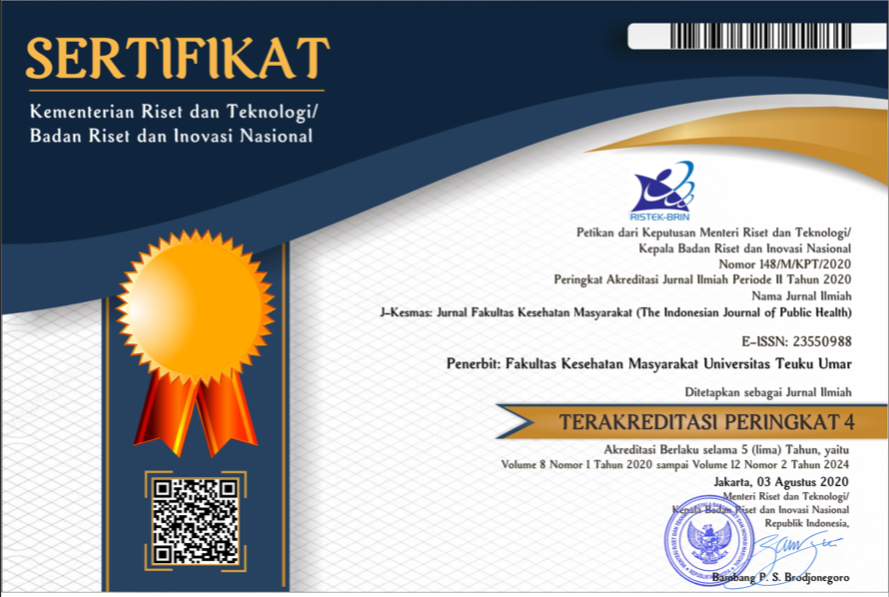Health Workers in Samarinda City: An Examination of Their Distribution Based on Strategic Issues
Abstract
Providers and organizers of health care in the city are health professionals. The number of health workers needed in Samarinda has not yet been determined according to WHO guidelines, which is a ratio that compares the number of health workers to the population. The method used in this study is a descriptive-analytical non-experimental design (cross-sectional). Following the study's goals, research participants used secondary data from the Central Statistics Agency's report for Samarinda City in 2018/2019 in the form of social and population data. Results: The number of doctors in Samarinda did not meet the WHO minimum requirements for the ratio of doctors to population of 1:2,500, with a ratio of 1:10,249 in the Samarinda Seberang district. The number of nurses is identical, but the standard ratio of 1:855 cannot be met; six sub-districts fail to meet the ratio, Sungai Pinang is the most effective sub-district in terms of achieving the nurse-to-population ratio. Apart from Samarinda Ulu and Samarinda Kota, the distribution of pharmacists has caught the attention of almost all districts in the city of Samarinda, a total of eight districts. Even one pharmacy in the Sungai Pinang district must serve 54,386 people.. Conclusion: The distribution of health workers in Samarinda is not equally distributed, owing primarily to external issues.
Keywords
Full Text:
PDFReferences
Agung Dwi Laksono, Ilham Akhsanu Ridlo, E. E. (2020). DISTRIBUTION ANALYSIS OF DOCTORS IN INDONESIA. Indonesian Journal of Health Administration, Vol 8, No(http://dx.doi.org/10.20473/jaki.v8i1.2020.29-39).
Anand, S. & W. (2010). Measuring health workforce inequalities: methods and application to China and India. Geneva, Switzerland, WHO Press.
Arifudin, Sudirman, M. andri. (2017). Evaluasi Sistem Manajemen Sumber Daya Manusia Pada Penempatan Kerja Petugas di UPT Puskesmas Lembasada, 7(1).
Badan Pusat Statistik (BPS RI). (2020). Total Population by Sex 2010-2018.
Badan Pusat Statistik (BPS RI) Padang City. (2018). Population by Sex.
Badan Pusat Statistik (BPS RI) West Sumatera Province. (2019). Health Workers in Padang City,
https://sumbar.bps.go.id/indicator/30/95/1/jumlah-.
Bank, W. (2017). World Bank Country and Lending Groups [Online], https://datahelpdesk.worldbank.org/knowledgebase/articles/906519, accessed Jun 16, 2020.
Bonenberger, M., Aikins, M., Akweongo, P., & Wyss, K. (2014). The effects of health worker motivation and job satisfaction on turnover intention in Ghana: A cross-sectional study. Human Resources for Health, 12(1), 1–12. http://doi.org/10.1186/1478-4491-12-43
BPS. (2010). Sensus penduduk (SP) 2010 dan proyeksi penduduk Indonesia 2015-2045/BPS-Statistics Indonesia.
Campbell, J., Dussault, G., Buchan, J., et al. (2013). A universal truth: no health without a workforce. Forum report, Third Global Forum on Human Resources for Health, Recife, Brazil. Geneva, Global Health Workforce Alliance, and World Health Organization.
Chongsuvivatwong V, Phua KH, Yap MTet al. (2011). Health and healthcare systems in Southeast Asia: diversity and transitions. The Lancet, 377: 429–37.
Dewi, S. L. (2013). Kebijakan Untuk Daerah Dengan Jumlah Tenaga Kesehatan Rendah.
Dinas Kesehatan Kota Samarinda. (2016). Profil kesehatan kota samarinda tahun 2016.
Dinas PU. (2014). Laporan Pembangunan Strategis Kota Samarinda, 116–149.
Dussault, G. & Dubois, C.-A. (2003). Human resources for health policies: a critical component in health policies. Human resources for health, 1, 1.
Dyani Primasari Sukamdi, Lutfan Lazuardi, S. (2015). Analisis Distribusi Apotek Dengan Sisitem Informasi Geografis.
Elisa Maria Maffioli, Thiago Augusto Hernandes Rocha, Gabriel Vivas, Carlos Rosales, Catherine Staton, J. R. N. V. (2019). Addressing inequalities in medical workforce distribution: evidence from a quasi-experimental study in Brazil. BMJ Journals, Volume 4,
(http://dx.doi.org/10.1136/ bmjgh-2019-001827).
Fernandez, J. L. (2017). Overemployment of Workers in Penang, Malaysia: An Empirical Analysis. The Journal of Asian Finance, Economics and Business [Korea Science], Volume 4 I.
Gale, T. C. E., Chatterjee, A., Mellor, N. E., & Allan, R. J. (2016). Health workers focused on distributed simulation for improving the capability of health systems in Liberia. Simulation in Healthcare, 11(2), 75–81. http://doi.org/10.1097/SIH.0000000000000156
Ghosh, S. (2014). Equity in the utilization of healthcare services in India: evidence from National Sample Survey. International journal of health policy and management, 2, 29.
KD Rao, R Shahrawat, A. B. (2016). Composition and distribution of the health workforce in India: estimates based on the National Sample Survey data.
Kemenkes RI. (2014). Panduan Praktik Klinis Bagi Dokter di Fasilitas Pelayanan Kesehatan Primer. Menteri Kesehatan Republik Indonesia, 332–337. http://doi.org/10.1017/CBO9781107415324.004
Kemenkumham. (2016). Berita Negara Republik Indonesia, (1644), 1–56.
Kriti Prasad, Colleen Mc Loughlin, Martin Stillman. (2021). Prevalence and correlates of stress and burnout among U.S. healthcare workers during the COVID-19 pandemic: A national cross-sectional survey study. Clinical Medicine Part of The Lancet Discovery Science, Volume 35, https://doi.org/10.1016/j.eclinm.2021.100879.
Liesl Grobler, Ben J Marais, S. M. (2015). Interventions for increasing the proportion of health professionals practicing in rural and other underserved areas. Cochrane Library, https://doi.org/10.1002/14651858.CD005314.pub3.
Manyazewal, T. (2017). Using the World Health Organization health system building blocks through a survey of healthcare professionals to determine the performance of public healthcare facilities. Archives of Public Health, 75(1), 1–8. http://doi.org/10.1186/s13690-017-0221-9
Masa Higo, H. T. K. (2014). Global population aging: Unequal distribution of risks in later life between developed and developing countries. Global Social Policy [SAGE Journals], 15, 2.
Meliala, A. (2005). Desentrlisasi Manajemen Sumber Daya Manusia Kesehatan: Pengalaman Implementasi di Daerah Istimewa Yogyakarta, Desentralisasi Kesehatan di Indonesia dan Perubahan Fungsi Pemerintah 2001-2003, (Gama Press. Yogyakarta).
Nurhotimah. (2015). Analisis Beban Kerja Untuk SDM Kesehatan. Retrieved from https://mediakom.sehatnegeriku.com/analisis-beban-kerja-untuk-sdm-kesehatan/
Rangga Yudistira. (2014). Perencanaan SDM Kesehatan, Rakerkesda Provinsi Bengkulu (Accessed on March 18.
Review, T. T. (2010). The Temasek Review. Two out of three doctors in Singapore are "foreign-trained", Jan 12, 2010. http://www.temasekreview. com/2010/01/12/two-out-of-three-doctors-in-singapore-are-foreigntrained/ (accessed June 20, 2020).
Slamet, S. A. M. B. T. K. dan G. K. K. (2018). Kebijakan Kementerian Kesehatan Dalam Pengaturan Dokter dan Dokter Gigi di Era Global. Retrieved from http://www.kki.go.id/assets/data/menu/Kemenkes_RI_-_Slamet_MEA_Makassar_23_April_18.pdf
Walikota Samarinda. (2018). Mayor of Samarinda Regulation No. 8 of 2018 concerning the SAMARINDA SMART CITY MASTERPLAN.
WHO. (2006). World health report 2006. Geneva, Switzerland: World Health Organization, 2006.
WHO. (2016). WHO | Global tuberculosis report 2016. WHO 2016
DOI: https://doi.org/10.35308/j-kesmas.v9i1.3574
Refbacks
- There are currently no refbacks.
Managed by Fakultas Kesehatan Masyarakat
Published by Universitas Teuku Umar
Website: http://jurnal.utu.ac.id/jkesmas
Email: jkemas@utu.ac.id 
This work is licensed under a Creative Commons Attribution-ShareAlike 4.0 International License.







.jpg)


